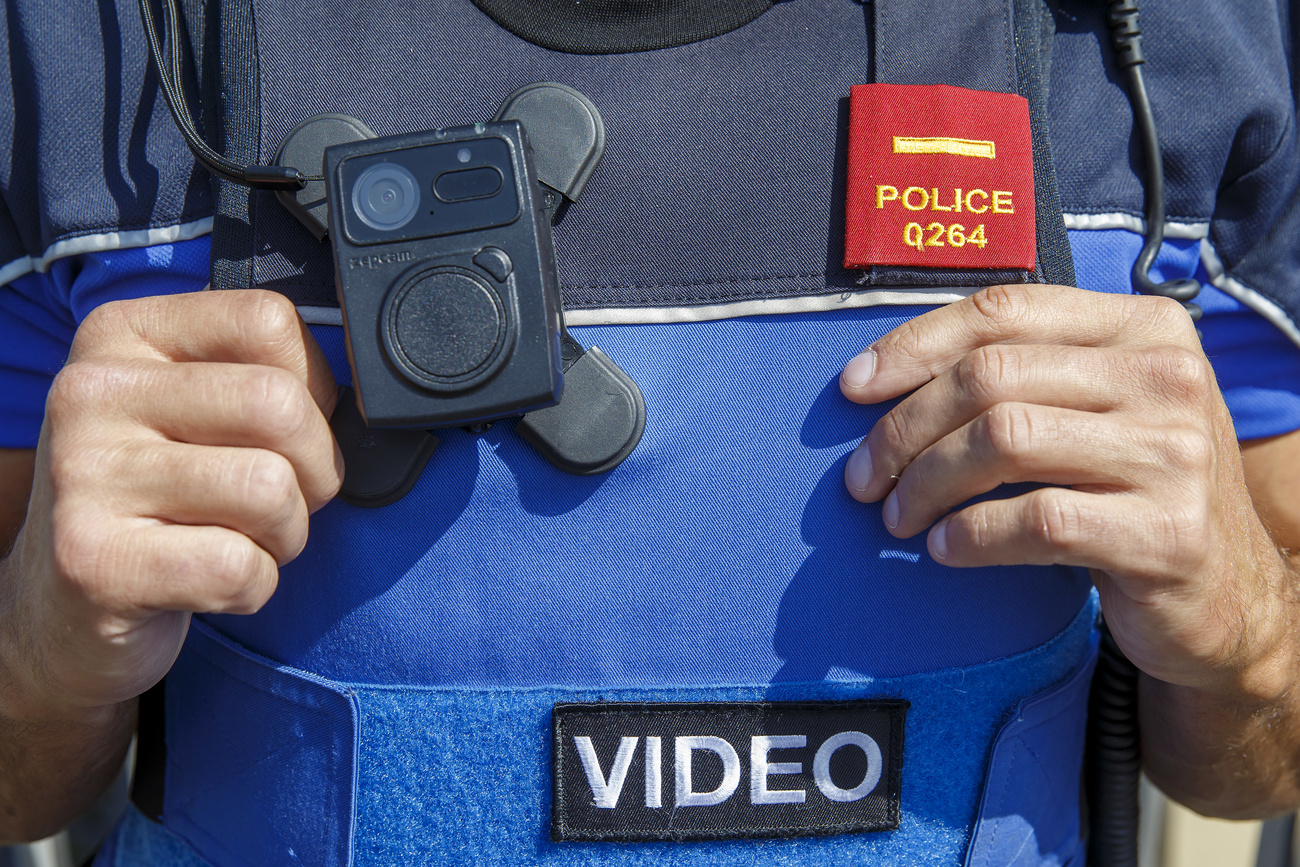
Bodycams on Swiss trains: will they keep trouble off the rails?

From September, Swiss Federal Railways transport police will be equipped with body cameras, also known as bodycams. These devices are being introduced to help de-escalate conflicts and increase accountability.
This follows similar use in countries such as the United Kingdom and the United States. In these countries, bodycam implementation has been more or less successful, raising ethical questions surrounding transparency and accountability, such as who can view the footage, how is it stored and how is it shared.
A ‘more aggressive’ society
The Swiss Federal Railways cites an increase in aggression against its employees and passengers as the primary reason for the implementation of bodycams. “These social developments are a concern for us,” Moritz Weisskopf, a media speaker for the Swiss Federal Railways, tells SWI swissinfo.ch in an email.
Bodycams are small cameras typically attached to the chest of a police or security officer. In a press release, Swiss Federal Railways announced that 100 body cameras would be distributed among their 200 transport police officers. When on duty, each team will have at least one bodycam in operation.

In accordance with Swiss law, officers must verbally announce when they are filming. The bodycam emits a sound when recording begins, and a red light flashes while it is filming. The footage is stored for 100 days and cannot be manually altered or deleted, according to Swiss Federal Railways.
+Swiss rail police to be equipped with body cameras
Lessons from abroad
In the UK, bodycams have been in use since 2006. At the time, they were implemented to “speed up justice and defuse potentially violent situations”, saidExternal link Bernard Hogan-Howe, the then-commissioner of the London Metropolitan Police.
New York City became the first major police department in the US to adopt bodycams in 2013, following a court ruling that found police were disproportionately targeting marginalised groups in stop-and-frisk actions. Since then, bodycams have become widely used across the country.
Research shows mixed results
The Associated Press (AP) reportedExternal link that research consistently shows a decrease in citizen complaints when bodycams are in use. This could be contributed to the awareness that both private individuals and police officers are being filmed, it writes. Another studyExternal link by the US National Policing Institute found that body cameras increased the perception that officers were acting in a procedurally just and legitimate manner.
Los Angeles Police Commander Steve Lurie told the AP news agency in June 2023 that bodycams were the most backed tool among his officers. “I think it is absolutely accurate to say that in Los Angeles this is now a favourite tool of our street cops,” he said.
This sentiment is echoed in the UK: a study by the University of Cambridge across four UK and two US police forces showed that complaints by members of the public against officers fell by 93% over 12 months compared to the year prior.
Bodycams not a ‘magic bullet’
Currently two police forces, in cantons Bern and Zurich, have implemented the use of body cameras.
The Bernese cantonal police have been using bodycams since 2021, and canton Zurich implemented them this July, following a pilot project conducted in 2017 by the Zurich University of Applied Sciences (ZHAW) to assess the effects of bodycam usage. The pilot project included Zurich city police and Swiss Federal Railways transport police.
The study compared surveys completed by police officers during shifts when a bodycam was worn versus shifts when they were not. Officers reported a reduction in physical violence during shifts where bodycams were used, although the results were not statistically significant. The study concludes that while the trial does show indications of de-escalation, it was not able to prove that this was due to the bodycam devices.
During the pilot project, in 12 cases in which a bodycam was recording, it was the civilian who requested that the camera be turned on.

The ZHAW pilot project also included an assessment by Zurich’s public prosecutor’s office, which found the footage valuable for preserving evidence. The recorded material provided important information that could be incorporated into the overall assessment of evidence.
While this demonstrated a positive development, bodycams were not a magic bullet, said Patrick Manzoni, one of the researchers of the ZHAW pilot project in an interviewExternal link with Swiss public radio, SRF on August 14.
“Body cameras are a great tool, and if used properly, likely one of the best advances in policing,” said Sean Smoot, from the Illinois Public Pension Fund Association, a not-for-profit umbrella organisation representing police and fire officers. “But cameras should not be a replacement for good first-line supervision that occurs in-person in real time.”
Can Switzerland avoid bodycam pitfalls?
Bodycam footage has been at the centre of numerous controversies in countries where bodycams are widely used.
In the UK, many complaints against bodycam usage are serious, reports the BBC. Allegations include the sharing of footage between officers in person, on messaging apps, and on social media, as well as footage being reported as lost, deleted or not marked as evidence. This includes an instance in which a woman alleged she had been raped by an officer.
Many such cases have made international headlines. The 2022 Robb Elementary school shooting in Uvalde, Texas, shocked the world and attracted media attention, primarily due to the apparent mishandling by the Uvalde police force, in which officers were recorded waiting more than 70 minutes before confronting the gunman.

The bodycam footage was only released earlier this August. This is two years after the incident and following a lawsuit brought by the Associated Press and other news agencies.
Transparency is a two-way street, Beat Gerber from NGO Amnesty International Switzerland told SRF in an interviewExternal link on August 14. Gerber says that footage taken by bodycams should be made available to individuals who want it.
+Swiss police cry foul over citizen filming of arrests
While Switzerland does not have the same level of crime as some other countries, there have been incidents where bodycam footage might have provided clarity.
In 2018, Mike Ben Peter, a 39-year-old Nigerian man, died while being arrested after resisting a drug control in Lausanne. Six police officers involved were twice tried for negligent homicide at the Vaud Cantonal Court and were twice acquitted.
+Swiss police officers cleared again of killing Nigerian man
The indictment was only six pages long and did not describe the incidents in great detail. It was therefore not clear which of the six police officers was accused of what.

In the second ruling, judges referred to forensic medical reports. The reports determined that it was impossible to say with certainty that Peters died as a result of the police intervention and the prone position in which he was held. In this situation, could a bodycam have presented additional evidence?
Over 22,000 cameras on Swiss trains
Surveillance is not a new tool in train stations and trains throughout Switzerland. Currently there are about 2,400 cameras in stations and buildings operated by the Swiss Federal Railways. Around 22,300 cameras are installed throughout train carriages.

That makes the additional 100 bodycams distributed among the transport police department seem like a drop in the bucket in comparison.
But the Swiss Federal Railways says bodycams will not be used as a method of surveillance, rather as a deterrent for aggression and a tool for de-escalation.
This decision was made largely due to the reported increase of aggression against employees and passengers. “The safety of our customers and our employees is our number one priority,” Weisskopf said. “Bodycams contribute to the increased feeling of safety for passengers and employees as well as for the protection of the transport police.”

To ensure the privacy of the video recordings, only specialised transport police officers have access to the footage. The recordings are stored on Swiss Federal Railways servers in Switzerland and are permanently deleted after 100 days. This is in accordance with the Federal Railways’ cybersecurity requirements.
Amnesty International argues that police should not be able to decide on their own when a camera is recording. In a written response to a proposed revision to the Police Act in 2023, the NGO called on legislation to be made that requires police to record at any instance of confrontation.
However, contrary to the request made by Amnesty International Switzerland, private individuals cannot request access to recordings that include them. Private individual also cannot request not to be filmed; that decision rests solely with the transport officer. “If the bodycam is used in a situation where the safety of employees or passengers is at stake, the safety of people outweighs the right to one’s own image,” Weisskopf said.
More
Edited by Virginie Mangin

In compliance with the JTI standards
More: SWI swissinfo.ch certified by the Journalism Trust Initiative































You can find an overview of ongoing debates with our journalists here . Please join us!
If you want to start a conversation about a topic raised in this article or want to report factual errors, email us at english@swissinfo.ch.